水处理微生物学课后答案
武理工《水处理生物学》课后习题及答案12水生植物的水质净化作用及其应用

第十二章水生植物的水质净化作用及其应用1.水生植被健全的水体,其水质通常比较清澄,为什么?答:大型水生植物主要通过物理和生物化学作用促进水中悬浮物质的沉降。
物理作用主要是由于大型水生植物在水中形成的茂密植被具有抑制风浪和减缓水流的功能,由此可促进水中悬浮物的沉降,以及减少底泥中颗粒物的再悬浮。
生物化学作用则是指植物根部释放出氧气形成根际氧化区,使底泥由厌氧状态转变为好氧状态,避免因有机物厌氧分解导致的底泥上浮,因此有水生植被存在的水体,水质都比较澄清。
2.大型水生植物能吸收或分解哪些污染物?答:水生植物直接吸收、降解的污染物包括两大类:氮磷等植物营养物质和对水生生物有毒害作用的某些重金属和有机物。
3.大型水生植物抑制浮游藻类生长的主要机理是什么?答:大型水生植物和浮游藻类同为水体初级生产者,相互之间具有竞争抑制的特点,在大型水生植物占优势的情况下,藻类的生长可以被抑制。
大型水生植物主要通过以下两种机制抑制藻类生长:(1)资源竞争抑制(2)释放抑藻化感物质4.浮游藻类有哪些水质净化功能?答:(1)对氮磷的吸收氮磷是浮游藻类必需的营养物质,因此藻类大量生长时,可以吸收水中的氮磷转化为自身的结构组成物质。
(2)对重金属的去除浮游藻类可以吸收富集水中的重金属。
藻类去除重金属的过程包括吸附和转移两个阶段。
(3)对有机物的去除藻类对有机物的去除机理分为两种:转化降解和富集。
5.漂浮植物水处理系统的水质净化机理是什么?答:漂浮植物水处理系统依靠植物和微生物的共同作用完成水质净化。
漂浮植物在塘表面形成一个垫层,垫层的下面由于植物释放氧气在根系附近形成好氧层,向下随氧含量逐渐减少形成兼氧层和厌氧层。
三个层中存在对应的好氧、兼氧、厌氧微生物群落。
塘内有机物的降解主要通过微生物来完成。
氮的去除主要通过四个过程完成:(1)植物的吸收;(2)随固体颗粒物的沉降;(3)硝化、反硝化;(4)氨的挥发。
磷的去除主要是通过植物的吸收和沉降作用。
水处理生物学习题及答案
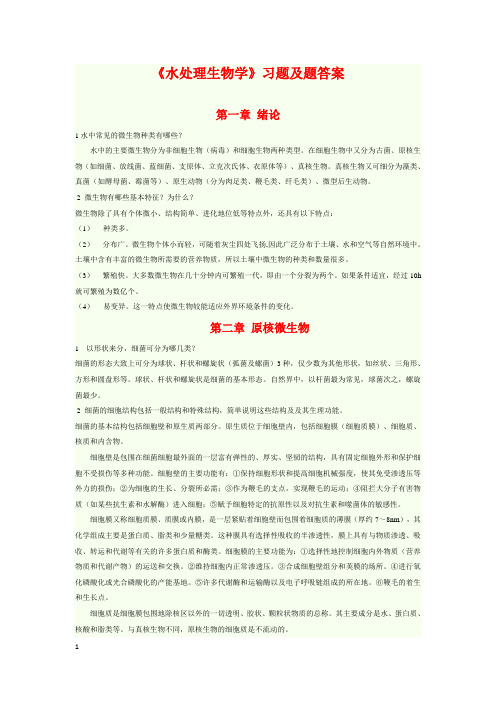
《水处理生物学》习题及题答案第一章绪论1水中常见的微生物种类有哪些?水中的主要微生物分为非细胞生物(病毒)和细胞生物两种类型。
在细胞生物中又分为古菌、原核生物(如细菌、放线菌、蓝细菌、支原体、立克次氏体、衣原体等)、真核生物。
真核生物又可细分为藻类、真菌(如酵母菌、霉菌等)、原生动物(分为肉足类、鞭毛类、纤毛类)、微型后生动物。
2 微生物有哪些基本特征?为什么?微生物除了具有个体微小、结构简单、进化地位低等特点外,还具有以下特点:(1)种类多。
(2)分布广。
微生物个体小而轻,可随着灰尘四处飞扬,因此广泛分布于土壤、水和空气等自然环境中。
土壤中含有丰富的微生物所需要的营养物质,所以土壤中微生物的种类和数量很多。
(3)繁殖快。
大多数微生物在几十分钟内可繁殖一代,即由一个分裂为两个。
如果条件适宜,经过10h 就可繁殖为数亿个。
(4)易变异。
这一特点使微生物较能适应外界环境条件的变化。
第二章原核微生物1 以形状来分,细菌可分为哪几类?细菌的形态大致上可分为球状、杆状和螺旋状(弧菌及螺菌)3种,仅少数为其他形状,如丝状、三角形、方形和圆盘形等。
球状、杆状和螺旋状是细菌的基本形态。
自然界中,以杆菌最为常见,球菌次之,螺旋菌最少。
2 细菌的细胞结构包括一般结构和特殊结构,简单说明这些结构及及其生理功能。
细菌的基本结构包括细胞壁和原生质两部分。
原生质位于细胞壁内,包括细胞膜(细胞质膜)、细胞质、核质和内含物。
细胞壁是包围在细菌细胞最外面的一层富有弹性的、厚实、坚韧的结构,具有固定细胞外形和保护细胞不受损伤等多种功能。
细胞壁的主要功能有:①保持细胞形状和提高细胞机械强度,使其免受渗透压等外力的损伤;②为细胞的生长、分裂所必需;③作为鞭毛的支点,实现鞭毛的运动;④阻拦大分子有害物质(如某些抗生素和水解酶)进入细胞;⑤赋予细胞特定的抗原性以及对抗生素和噬菌体的敏感性。
细胞膜又称细胞质膜、质膜或内膜,是一层紧贴着细胞壁而包围着细胞质的薄膜(厚约7~8nm),其化学组成主要是蛋白质、脂类和少量糖类。
水处理微生物试题及答案
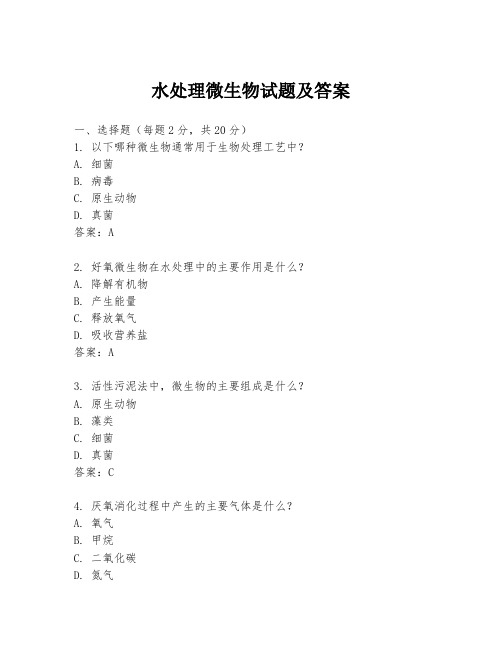
水处理微生物试题及答案一、选择题(每题2分,共20分)1. 以下哪种微生物通常用于生物处理工艺中?A. 细菌B. 病毒C. 原生动物D. 真菌答案:A2. 好氧微生物在水处理中的主要作用是什么?A. 降解有机物B. 产生能量C. 释放氧气D. 吸收营养盐答案:A3. 活性污泥法中,微生物的主要组成是什么?A. 原生动物B. 藻类C. 细菌D. 真菌答案:C4. 厌氧消化过程中产生的主要气体是什么?A. 氧气B. 甲烷C. 二氧化碳D. 氮气5. 以下哪种微生物在水处理中不常见?A. 硝化细菌B. 反硝化细菌C. 产甲烷细菌D. 乳酸菌答案:D6. 微生物在水处理中的作用不包括以下哪项?A. 去除悬浮固体B. 去除有机物C. 去除氮和磷D. 产生有毒物质答案:D7. 以下哪种微生物在水处理中具有硝化作用?A. 蓝藻B. 绿藻C. 硝化细菌D. 反硝化细菌答案:C8. 在水处理中,微生物的生物量通常通过什么指标来衡量?A. 化学需氧量(COD)B. 总悬浮固体(TSS)C. 总氮(TN)D. 活性污泥浓度(MLSS)答案:D9. 以下哪种微生物在水处理中具有反硝化作用?B. 绿藻C. 硝化细菌D. 反硝化细菌答案:D10. 微生物在水处理中的生物膜法中,生物膜的主要组成是什么?A. 细菌B. 藻类C. 原生动物D. 真菌答案:A二、填空题(每空1分,共20分)1. 微生物在水处理中的作用包括去除______、______、______等污染物。
答案:有机物、氮、磷2. 好氧微生物需要______作为电子受体来进行代谢活动。
答案:氧气3. 在水处理中,微生物的生物量通常通过测量______来确定。
答案:活性污泥浓度(MLSS)4. 微生物在水处理中的生物膜法中,生物膜主要由______组成。
答案:细菌5. 微生物在水处理中的厌氧消化过程中,主要产生的气体是______。
答案:甲烷三、简答题(每题10分,共40分)1. 简述微生物在水处理中的作用。
水处理生物学 第五版 顾夏声 课后答案

水处理生物学思考题一、绪论1"水处理生物学"的研究对象是什么?"水处理生物学"研究的对象主要集中在与水中的污染物迁移、分解及转化过程密切相关的微生物、微型水生动物和水生/湿生植物,特别是应用于水处理工程实践的生物种类。
细菌等原核微生物在水处理工程中通常起着关键的作用,是水处理生物学研究的重点3微生物有哪些基本特征?为什么?微生物除了具有个体微小、结构简单、进化地位低等特点外,还具有以下特点:(1)种类多。
(2)分布广。
微生物个体小而轻,可随着灰尘四处飞扬,因此广泛分布于土壤、水和空气等自然环境中。
土壤中含有丰富的微生物所需要的营养物质,所以土壤中微生物的种类和数量很多。
(3)繁殖快。
大多数微生物在几十分钟内可繁殖一代,即由一个分裂为两个。
如果条件适宜,经过10h 就可繁殖为数亿个。
(4)易变异。
这一特点使微生物较能适应外界环境条件的变化。
二、原核微生物3细菌的细胞结构包括一般结构和特殊结构,简单说明这些结构及及其生理功能。
细菌的基本结构包括细胞壁和原生质两部分。
原生质位于细胞壁内,包括细胞膜(细胞质膜)、细胞质、核质和内含物。
细胞壁是包围在细菌细胞最外面的一层富有弹性的、厚实、坚韧的结构,具有固定细胞外形和保护细胞不受损伤等多种功能。
细胞壁的主要功能有:①保持细胞形状和提高细胞机械强度,使其免受渗透压等外力的损伤;②为细胞的生长、分裂所必需;③作为鞭毛的支点,实现鞭毛的运动;④阻拦大分子有害物质(如某些抗生素和水解酶)进入细胞;⑤赋予细胞特定的抗原性以及对抗生素和噬菌体的敏感性。
细胞膜又称细胞质膜、质膜或内膜,是一层紧贴着细胞壁而包围着细胞质的薄膜(厚约7~8nm ),其化学组成主要是蛋白质、脂类和少量糖类。
这种膜具有选择性吸收的半渗透性,膜上具有与物质渗透、吸收、转运和代谢等有关的许多蛋白质和酶类。
细胞膜的主要功能为:①选择性地控制细胞内外物质(营养物质和代谢产物)的运送和交换。
武理工《水处理生物学》课后习题及答案06微生物的生理特性

第六章微生物的生理特性1 细菌细胞中主要含有哪些成分?细菌需要哪些营养?各种营养物质的功能是什么?答:细菌细胞中最重要的组分是水,约占细胞总质量的80%,一般为70%~90%,其他10%~30%为干物质。
干物质中有机物占90%~97%左右,其主要化学元素是C、H、O、N、P、S;另外约3%~10%为无机盐分(或称灰分)。
应注意,不同微生物细胞化学组分不同;一种微生物在不同的生长阶段,其化学组分也不同。
微生物的营养要求在元素水平上都需要20种左右,且以碳、氢、氧、氮、硫、磷为主;在营养水平上则都在六大类的范围内,即碳源、氮源、能源、生长因子、无机盐和水。
提供细胞组分或代谢产物种碳素来源的各种营养物质称为碳源。
它的作用是提供细胞骨架和代谢物质中碳素的来源以及生命活动所需要的能量。
异养微生物在元素水平上最适碳源适"C·H·O"型。
提供细胞组分中氮素来源的各种物质称为氮源。
它的作用适提供细胞新陈代谢中所需的氮素合成材料。
极端情况下(如饥饿状态),氮源也可为细胞提供生命活动所需的能量。
能为微生物生命活动提供最初能量来源的营养物质和辐射能,称为能源。
各种异养生物的能源就是碳源。
化能自养微生物的能源十分独特,它们都是一些还原态的无机物。
生长因子是一类调节微生物正常代谢所必需,但不能利用简单的碳、氮源自行合成的有机物。
按微生物对生长因子的需要与否,可把它们分成生长因子自养型微生物、生长因子异养型微生物和生长因子过量合成型微生物三种。
无机盐或矿质元素主要为微生物提供碳源、氮源以外的各种重要元素。
无机盐类在细胞中的主要作用是:1) 构成细胞的组成成分。
2) 酶的组成成分。
3) 酶的激活剂。
4) 维持适宜的渗透压。
5) 自养型细菌的能源。
6) 无氧呼吸时的氢受体。
水在微生物细胞内有两种存在状态:自由水和结合水。
它们的生理作用主要有以下几点:1) 溶剂作用。
所有物质都必须先溶解于水,然后才能参与各种生化反应。
武理工《水处理生物学》课后习题及答案03古菌
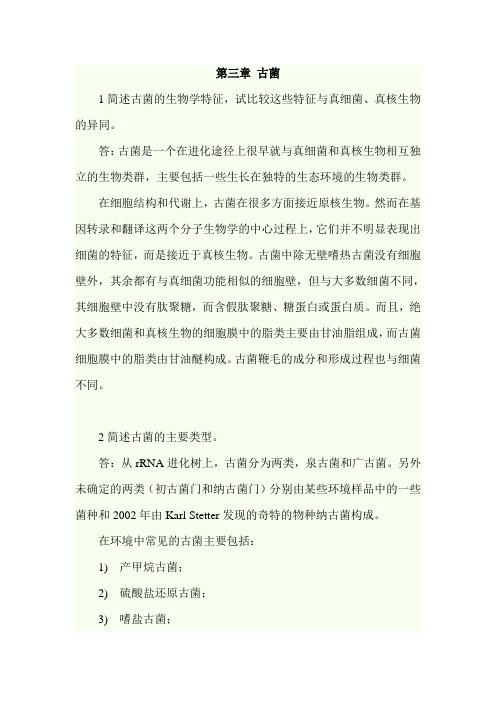
第三章古菌1简述古菌的生物学特征,试比较这些特征与真细菌、真核生物的异同。
答:古菌是一个在进化途径上很早就与真细菌和真核生物相互独立的生物类群,主要包括一些生长在独特的生态环境的生物类群。
在细胞结构和代谢上,古菌在很多方面接近原核生物。
然而在基因转录和翻译这两个分子生物学的中心过程上,它们并不明显表现出细菌的特征,而是接近于真核生物。
古菌中除无壁嗜热古菌没有细胞壁外,其余都有与真细菌功能相似的细胞壁,但与大多数细菌不同,其细胞壁中没有肽聚糖,而含假肽聚糖、糖蛋白或蛋白质。
而且,绝大多数细菌和真核生物的细胞膜中的脂类主要由甘油脂组成,而古菌细胞膜中的脂类由甘油醚构成。
古菌鞭毛的成分和形成过程也与细菌不同。
2简述古菌的主要类型。
答:从rRNA进化树上,古菌分为两类,泉古菌和广古菌。
另外未确定的两类(初古菌门和纳古菌门)分别由某些环境样品中的一些菌种和2002年由Karl Stetter发现的奇特的物种纳古菌构成。
在环境中常见的古菌主要包括:1) 产甲烷古菌;2) 硫酸盐还原古菌;3) 嗜盐古菌;4) 嗜热古菌;5) 无细胞壁的嗜热嗜酸古菌等。
3简述产甲烷古菌的特征与应用。
答:产甲烷古菌是一大群在严格厌氧条件下产生甲烷的菌,形态多样,有球形、杆形、螺旋形、长丝形和八叠球形等。
大多数种可利用H2/CO2,很多种可利用甲酸。
一般的产甲烷细菌都是中温性的,最适宜的温度在25~40℃之间,高温性产甲烷细菌的适宜温度则在50~60℃之间。
产甲烷细菌生长最适宜的pH范围约在6.8~7.2之间。
如pH值低于6或高于8,细菌的生长繁殖将受到极大影响。
产甲烷古菌可用于有机污染物的厌氧生物处理。
《水处理微生物学》复习题及答案

理论课部分1说明水污染的来源、途径及危害。
答:(1)工业污染源。
主要污染地下水和地面水。
形成硫酸雾、酸雨;汞污染,形成“水俣病”;镉污染,形成“骨痛病”;短期集中排放,引起水生物大量死亡;还可引起农业减产。
(2)生活污染源。
污染地面水、地下水。
其中的病原微生物可引起流行病爆发。
其中的氮和磷可引起水体富营养化,造成水生生物死亡。
(3)面源污染。
农田施的化肥、农药,其中的氮会流失,引起水体污染,在水中形成亚硝酸胺可致癌;蔬菜、水果中的农药在人体内累积,形成潜在危害。
2什么是微生物(Microbe)?答:对形体微小,形态简单的低等生物的统称。
3微生物的共同特性有哪些?答:(1)形体微小,结构简单;(2)比表面积大,代谢能力强;(3)生长旺盛,繁殖快;(4)适应力强,易变异;(5)分布广,种类多。
4水中有哪些常见的微生物?答:非细胞类型:病毒(动物病毒、植物病毒、昆虫病毒),噬菌体(细菌病毒),真菌病毒等。
原核细胞类型:细菌、放线菌、蓝细菌、立克次氏体、衣原体、支原体等。
真核细胞类型:真菌(酵母菌、霉菌)、原生动物、微型后生动物、除蓝藻外的其它藻类等。
5试说明微生物在给排水工程中的作用和危害?(答:(1)污染水源。
水中有各种病原菌如伤寒杆菌、霍乱弧菌、痢疾杆菌及肝炎病毒等,它们可引起人类严重的传染病,这些病原菌是通过粪便污染水源。
因此了解水中的致病菌,设法去除,防止传染病的蔓延。
此外有些藻类可使水生色或产生气味,甚至引起水体富营养化,应对这些藻类加以控制。
(2)阻塞滤池、管道。
如藻类、放线菌、丝状细菌。
(3)影响工业产品的品质。
如藻类会使水呈现颜色,有些还会使水有鱼腥味或苦味。
(4)利用微生物处理废水。
生物滤池、活性污泥都是利用好氧微生物处理废水中溶解的和胶体的有机物。
污泥消化是利用厌氧微生物处理高浓度的有机废水。
生物的除磷脱氮也是利用微生物的作用来进行的。
(5)进行水体的净化。
污水排入河流、湖泊后,水体在一定限度内有自身的净化能力。
《水处理微生物学》复习题及答案

理论课部分1说明水污染的来源、途径及危害。
答:(1)工业污染源。
主要污染地下水和地面水。
形成硫酸雾、酸雨;汞污染,形成“水俣病”;镉污染,形成“骨痛病”;短期集中排放,引起水生物大量死亡;还可引起农业减产。
(2)生活污染源。
污染地面水、地下水。
其中的病原微生物可引起流行病爆发。
其中的氮和磷可引起水体富营养化,造成水生生物死亡。
(3)面源污染。
农田施的化肥、农药,其中的氮会流失,引起水体污染,在水中形成亚硝酸胺可致癌;蔬菜、水果中的农药在人体内累积,形成潜在危害。
2什么是微生物(Microbe)?答:对形体微小,形态简单的低等生物的统称。
3微生物的共同特性有哪些?答:(1)形体微小,结构简单;(2)比表面积大,代谢能力强;(3)生长旺盛,繁殖快;(4)适应力强,易变异;(5)分布广,种类多。
4水中有哪些常见的微生物?答:非细胞类型:病毒(动物病毒、植物病毒、昆虫病毒),噬菌体(细菌病毒),真菌病毒等。
原核细胞类型:细菌、放线菌、蓝细菌、立克次氏体、衣原体、支原体等。
真核细胞类型:真菌(酵母菌、霉菌)、原生动物、微型后生动物、除蓝藻外的其它藻类等。
5试说明微生物在给排水工程中的作用和危害?(答:(1)污染水源。
水中有各种病原菌如伤寒杆菌、霍乱弧菌、痢疾杆菌及肝炎病毒等,它们可引起人类严重的传染病,这些病原菌是通过粪便污染水源。
因此了解水中的致病菌,设法去除,防止传染病的蔓延。
此外有些藻类可使水生色或产生气味,甚至引起水体富营养化,应对这些藻类加以控制。
(2)阻塞滤池、管道。
如藻类、放线菌、丝状细菌。
(3)影响工业产品的品质。
如藻类会使水呈现颜色,有些还会使水有鱼腥味或苦味。
(4)利用微生物处理废水。
生物滤池、活性污泥都是利用好氧微生物处理废水中溶解的和胶体的有机物。
污泥消化是利用厌氧微生物处理高浓度的有机废水。
生物的除磷脱氮也是利用微生物的作用来进行的。
(5)进行水体的净化。
污水排入河流、湖泊后,水体在一定限度内有自身的净化能力。
水处理生物学课后题案-2
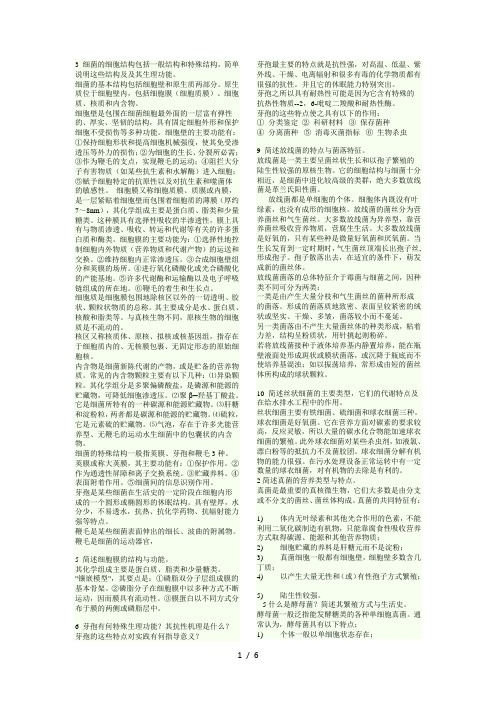
3 细菌的细胞结构包括一般结构和特殊结构,简单说明这些结构及及其生理功能。
细菌的基本结构包括细胞壁和原生质两部分。
原生质位于细胞壁内,包括细胞膜(细胞质膜)、细胞质、核质和内含物。
细胞壁是包围在细菌细胞最外面的一层富有弹性的、厚实、坚韧的结构,具有固定细胞外形和保护细胞不受损伤等多种功能。
细胞壁的主要功能有:①保持细胞形状和提高细胞机械强度,使其免受渗透压等外力的损伤;②为细胞的生长、分裂所必需;③作为鞭毛的支点,实现鞭毛的运动;④阻拦大分子有害物质(如某些抗生素和水解酶)进入细胞;⑤赋予细胞特定的抗原性以及对抗生素和噬菌体的敏感性。
细胞膜又称细胞质膜、质膜或内膜,是一层紧贴着细胞壁而包围着细胞质的薄膜(厚约7~8nm),其化学组成主要是蛋白质、脂类和少量糖类。
这种膜具有选择性吸收的半渗透性,膜上具有与物质渗透、吸收、转运和代谢等有关的许多蛋白质和酶类。
细胞膜的主要功能为:①选择性地控制细胞内外物质(营养物质和代谢产物)的运送和交换。
②维持细胞内正常渗透压。
③合成细胞壁组分和荚膜的场所。
④进行氧化磷酸化或光合磷酸化的产能基地。
⑤许多代谢酶和运输酶以及电子呼吸链组成的所在地。
⑥鞭毛的着生和生长点。
细胞质是细胞膜包围地除核区以外的一切透明、胶状、颗粒状物质的总称。
其主要成分是水、蛋白质、核酸和脂类等。
与真核生物不同,原核生物的细胞质是不流动的。
核区又称核质体、原核、拟核或核基因组,指存在于细胞质内的、无核膜包裹、无固定形态的原始细胞核。
内含物是细菌新陈代谢的产物,或是贮备的营养物质。
常见的内含物颗粒主要有以下几种:⑴异染颗粒。
其化学组分是多聚偏磷酸盐,是磷源和能源的贮藏物,可降低细胞渗透压。
⑵聚β─羟基丁酸盐。
它是细菌所特有的一种碳源和能源贮藏物。
⑶肝糖和淀粉粒,两者都是碳源和能源的贮藏物。
⑷硫粒,它是元素硫的贮藏物。
⑸气泡,存在于许多光能营养型、无鞭毛的运动水生细菌中的包囊状的内含物。
细菌的特殊结构一般指荚膜、芽孢和鞭毛3种。
【精品】水处理微生物学课后习题答案

水处理微生物学课后习题答案《水处理生物学》课后思考题第一章绪论1 "水处理生物学"的研究对象是什么?"水处理生物学"研究的对象主要集中在与水中的污染物迁移、分解及转化过程密切相关的微生物、微型水生动物和水生/湿生植物,特别是应用于水处理工程实践的生物种类。
细菌等原核微生物在水处理工程中通常起着关键的作用,是水处理生物学研究的重点。
2 水中常见的微生物种类有哪些?水中的主要微生物分为非细胞生物(病毒)和细胞生物两种类型。
在细胞生物中又分为古菌、原核生物(如细菌、放线菌、蓝细菌、支原体、立克次氏体、衣原体等)、真核生物。
真核生物又可细分为藻类、真菌(如酵母菌、霉菌等)、原生动物(分为肉足类、鞭毛类、纤毛类)、微型后生动物。
3 微生物有哪些基本特征?为什么?微生物除了具有个体微小、结构简单、进化地位低等特点外,还具有以下特点:(1)种类多。
(2)分布广。
微生物个体小而轻,可随着灰尘四处飞扬,因此广泛分布于土壤、水和空气等自然环境中。
土壤中含有丰富的微生物所需要的营养物质,所以土壤中微生物的种类和数量很多。
(3)繁殖快。
大多数微生物在几十分钟内可繁殖一代,即由一个分裂为两个。
如果条件适宜,经过10h就可繁殖为数亿个。
(4)易变异。
这一特点使微生物较能适应外界环境条件的变化。
4 微生物命名常用的双名法的主要规定是什么?一种微生物的名称由两个拉丁文单词组成,第一个是属名,用拉丁文名词表示,词首字母大写,它描述微生物的主要特征;第二个是种名,用拉丁文形容词表示,词首字母不大写,它描述微生物的次要特征。
有时候在前面所述的两个单词之后还会有一个单词,这个单词往往是说明微生物的命名人。
5 水中小型动物和水生植物在水体水质净化中各起什么样的作用?小型动物多指1~2mm以下的后生动物,它们与水处理过程,特别是环境水体水质净化过程有密切的关系,具有重要的生态功能。
底栖小型动物寿命较长,迁移能力有限,且包括敏感种和耐污种,故常称为"水下哨兵",能长期检测有机污染物的慢性排放。
《水处理微生物学》试卷习题参考答案

《水办理微生物学》试卷参照答案一、名词解说:(共15小题,每题2分,合计30分)1.微生物:微生物(microbe)是肉眼看不见或看不清楚的细小生物的总称,不是生物分类学上的观点。
微生物拥有个体细小、结构简单、进化地位低等特色。
2.寄生关系:寄生:一种小型生物(寄生物)生活在另一种较大型生物(寄主或宿主)的体内或体表,进行汲取营养进而使宿主细胞遇到损害甚至被杀死。
比如:噬菌体寄生在特定细菌细胞内,造成细菌细胞裂解死亡。
3.内质网:指细胞质中一个与细胞基质相隔绝、但相互相通的囊腔和细管系统,由脂质双分子层围成。
4.异染颗粒:异染颗粒又称挟转菌素。
因最先是在迂回螺菌中发现,用蓝色染料(如甲苯胺蓝和甲烯蓝)染色后不呈蓝色而呈紫红色,故名。
其化学组分是多聚偏磷酸盐,是磷源和能源的储藏物,可降低细胞浸透压。
5.荚膜:有些细菌生活在必定营养条件下,会向细胞壁外分泌出一层粘性多糖类物质,依据其厚度、可溶性及其在细胞表面的存在状态可将其称为荚膜、微荚膜、黏液层。
6.平和噬菌体:有—些噬菌体侵入宿主细胞后,其核酸整合到宿主细胞的核酸上同步复制,并随宿主细胞分裂而带到子代宿主细胞内,宿主细胞不裂解。
这些噬菌体,称为平和噬菌体。
7.主动运输:主动运输是细菌汲取营养物质的最主要方式。
它的最大持点是汲取运输过程中需要耗费能量,所以能够逆浓度差进行。
其余持点与促使扩散相像,也就是说需要载体蛋白的参加,经过鼓体蛋白的构象从亲协力的改变达成物质的汲取运输过程。
细菌的绝大多半营养物质都是超出这种方式进行汲取而进入细胞内部。
8.光能异养:属于这一营养种类的细菌极少,如红螺菌中的一些细菌以这种方式生长。
这种营养种类很特别,它不可以以CO2作为主要碳源或独一碳源,但又利用有机物(如异丙醉)作为供氢体,利用光能将CO2复原成细胞物质。
一般来说,光能异养型细菌生长时大多需要生长因子。
9.化能自养:有些细菌,如硝化细菌、铁细菌、某些硫磺细菌等,能氧化必定的无机化台物,利用其所产生的化学能,复原二氧化碳,合成有机碳化物,这一作用稼为化学合成作用。
武理工《水处理生物学》课后习题及答案07微生物的生长和遗传变异

第七章微生物的生长和遗传变异1.微生物是怎样繁殖的?答:微生物生长到一定阶段,便以二分裂的方式形成两个子细胞,子细胞又重复以上过程,这就是繁殖。
2.怎样利用微生物的生长曲线来控制污水生物处理的构筑物的运行?答:针对微生物的间歇培养,在污水生物处理过程中,为避免缓慢期的出现,可考虑采用处于对数生长期或代谢旺盛的污泥进行接种,另外增加接种量及采用同类型反应器的污泥接种可达到缩短缓慢期的效果。
如果维持微生物在生长率上升阶段(对数期)生长,则此时微生物繁殖很快,活力很强,处理污水的能力必然较高;但处理效果并不一定最好,因为微生物活力强大就不易凝聚和沉淀,并且要使微生物生长在对数期,则需有充分的食料,即污水中的有机物必须有较高的浓度,在这种情形下,相对地说,处理过的污水所含有机物浓度就要较高,所以利用此阶段进行污水的生物处理实际上难以得到较好的出水。
稳定期的微生物生长速率下降,细胞内开始积累贮藏物和异染颗粒、肝糖等,芽孢微生物也在此阶段形成芽孢,处于稳定期的污泥代谢活性和絮凝沉降性能均较好,传统活性污泥法普遍运行在这一范围。
衰老期阶段只出现在某些特殊的水处理场合,如延时曝气及污泥消化。
3.生物膜的主要成分是什么?答:生物膜是一种不可逆的黏附于固体表面的,被微生物胞外多聚物包裹的有组织的微生物群体。
生物膜中水份含量可高达97%。
除了水和微生物外,生物膜还可含有微生物分泌的大分子多聚物(主要是多聚糖)、吸附的营养物质和代谢产物及微生物裂解产物等。
4.请说明生物膜的形成过程和相应的特征。
答:生物膜的形成是一种动态的演变过程,首先是微生物黏附于表面,然后在表面形成微生物菌落,不同类型的菌落由细胞外多聚物包裹,生物膜成熟。
在黏附阶段,一些特殊基因的转录是活跃的,如铜绿假单胞菌algC、algD、algU、LacZ等基因,因为这些基因是细胞外多聚糖合成所必需的。
在形成微生物菌落阶段,胞外多糖(EPS)合成增加,微生物对抗生素的抗性有所提高。
水处理生物学思考题答案

水处理生物学思考题答案1微生物是肉眼看不见或看不清楚的微笑生物的总称。
它不是生物分类学上的概念。
基本特点:个体微小,结构简单,进化地位低。
共性:体积小面积大;种类多分布广;生长快繁殖快;易变异适应强。
2异:原核的核非常简单,没有核膜包围也没有核仁,只是一团裸露的且高度折叠缠绕的DNA分子,且细胞核中无蛋白质。
同:二者都是微生物都有微生物的特征。
3球菌、杆菌、螺旋菌、丝状菌。
4一般结构:细胞壁、原生质体。
原生质体包括细胞膜、细胞质、核质和内含物。
特殊结构:荚膜、菌胶团、芽孢、鞭毛、纤毛。
5G+细胞壁较厚、单层,由大量的肽聚糖和一定数量的磷壁酸组成,脂类组分很少。
G-细胞壁分为两层:外壁层和内壁层。
外层主要是脂多糖和脂蛋白组分,较厚,脂类占整个细胞壁比例的40%内层主要组分是肽聚糖,较薄。
染色过程:结晶红初染,碘液媒染,最后用番红或沙黄复染。
结果:G+蓝紫色,G-带上了复染番红或沙黄的颜色。
主要是由于两类细菌细胞壁的结构不同而导致的结果。
6荚膜:在细胞壁外常围绕着一层粘液,厚度不一,较薄时称为黏液层,相当厚时叫荚膜芽孢:有些杆菌和极少数球菌,在生活史的一定阶段,菌体内能形成圆形或椭圆形的结构,称为芽孢。
作用:1细菌的荚膜有保护作用,能保护细菌免受干燥,增强对某些病原菌的致病能力。
产荚膜细菌在污水生物处理中,对活性污泥的形成与沉降性能优重要作用。
2 芽孢含有特殊的抗热性物质和耐热性酶,能够抵抗极不适宜的环境。
7菌落:把细菌接种到固体培养基中,一个细菌经过迅速的生长,繁殖而形成很多的菌体聚集在一起的,肉眼可见的细菌集合体。
特征:典型的细菌菌落一般式1—3mm,圆形或椭圆形,湿润,较光滑,较透明,较粘稠,易挑取,质地均匀及正反面颜色一致等8营养菌丝:伸入营养物质内或漫生于营养物表面,吸收养料的菌丝气生菌丝:当营养菌丝生长到一定程度,就会生长为伸向空中的菌丝分生孢子:在生殖生长期气生菌丝的顶端形成孢子丝9原生动物在形态上虽然只有一个细胞,但在生理上却是一个完善的有机体,能和各细胞动物一样行驶营养,呼吸,排泄,生殖等机能10肉足类:大多数没有固定的形状,细胞质可伸缩变动而形成伪足,作为运动和摄食的胞器鞭毛类:其体表有一层坚硬的角质膜,保持身体的形态不变形,鞭毛长度大致与其体长相等或更长些,是运动器官。
华北理工《水处理生物学》章节习题及答案10微生物对污染物的分解与转化
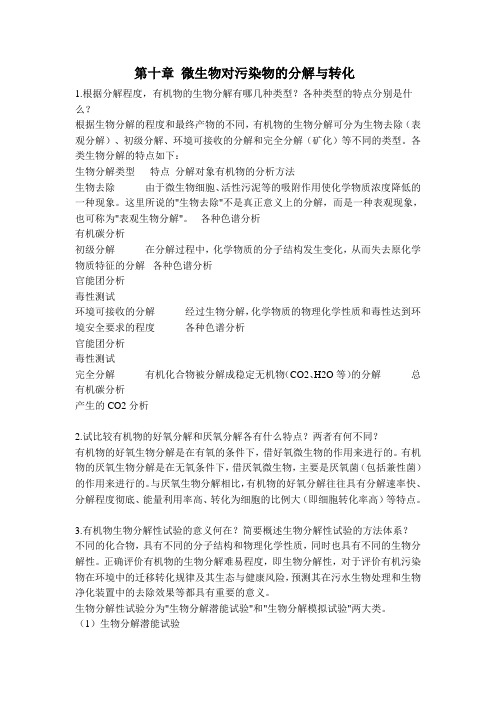
第十章微生物对污染物的分解与转化1.根据分解程度,有机物的生物分解有哪几种类型?各种类型的特点分别是什么?根据生物分解的程度和最终产物的不同,有机物的生物分解可分为生物去除(表观分解)、初级分解、环境可接收的分解和完全分解(矿化)等不同的类型。
各类生物分解的特点如下:生物分解类型特点分解对象有机物的分析方法生物去除由于微生物细胞、活性污泥等的吸附作用使化学物质浓度降低的一种现象。
这里所说的"生物去除"不是真正意义上的分解,而是一种表观现象,也可称为"表观生物分解"。
各种色谱分析有机碳分析初级分解在分解过程中,化学物质的分子结构发生变化,从而失去原化学物质特征的分解各种色谱分析官能团分析毒性测试环境可接收的分解经过生物分解,化学物质的物理化学性质和毒性达到环境安全要求的程度各种色谱分析官能团分析毒性测试完全分解有机化合物被分解成稳定无机物(CO2、H2O等)的分解总有机碳分析产生的CO2分析2.试比较有机物的好氧分解和厌氧分解各有什么特点?两者有何不同?有机物的好氧生物分解是在有氧的条件下,借好氧微生物的作用来进行的。
有机物的厌氧生物分解是在无氧条件下,借厌氧微生物,主要是厌氧菌(包括兼性菌)的作用来进行的。
与厌氧生物分解相比,有机物的好氧分解往往具有分解速率快、分解程度彻底、能量利用率高、转化为细胞的比例大(即细胞转化率高)等特点。
3.有机物生物分解性试验的意义何在?简要概述生物分解性试验的方法体系?不同的化合物,具有不同的分子结构和物理化学性质,同时也具有不同的生物分解性。
正确评价有机物的生物分解难易程度,即生物分解性,对于评价有机污染物在环境中的迁移转化规律及其生态与健康风险,预测其在污水生物处理和生物净化装置中的去除效果等都具有重要的意义。
生物分解性试验分为"生物分解潜能试验"和"生物分解模拟试验"两大类。
(1)生物分解潜能试验生物分解潜能试验的主要目的是评价有机物是否具有被生物分解的潜在性。
《水处理生物学》习题及题答案

第五章病毒
1病毒的特点
病毒是一类超显微(无法用光学显微镜辨认)、非细胞的、没有代谢功能的绝对细胞内寄生性生物。
病毒的个体十分微小,一般不能被细菌过滤器截留,其大小相差悬殊,大的直径超过200nm,而小的仅10nm左右。
2病毒的分类
根据病毒的宿主范围,可以将病毒分为噬菌体、动物病毒和植物病毒。
3病毒的繁殖
细胞核:在真菌的菌丝顶端细胞中,常常找不到细胞核。真核生物的细胞核由核被膜、染色质、核仁和核基质等构成。
细胞质:位于细胞质膜与细胞核膜之间的透明、粘稠、不断流动的溶胶,称为细胞质。
细胞器:内质网、核糖体、高尔基体、溶酶体、微体、线粒体、叶绿体、液泡、膜边体、几丁质媒体。
鞭毛与纤毛:某些真核微生物表面长有或长或短的、呈多毛发状的具有运动功能的细胞器,其中形态较长的、数量较少者称为鞭毛;而形态较短、数量较多者称为纤毛。
病毒是以复制方式繁殖,其繁殖过程分为吸附、侵入与脱壳、复制与合成、装置与释放四个步骤。
4噬菌体的种类
固体培养基上的细菌由于噬菌体浸染后出现的透明空斑,叫做噬菌斑。有一些噬菌体侵入宿主细胞后,其核酸整合到宿主细胞的核酸上同步复制,并随宿主细胞分裂而带到子代宿主细胞内,宿主细胞不裂解,这些噬菌体称为温和噬菌体,该现象称为溶源现象,被温和噬菌体侵染的细菌,称为溶源性细菌。
《水处理生物学》(顾夏声-第4版)课后习题答案
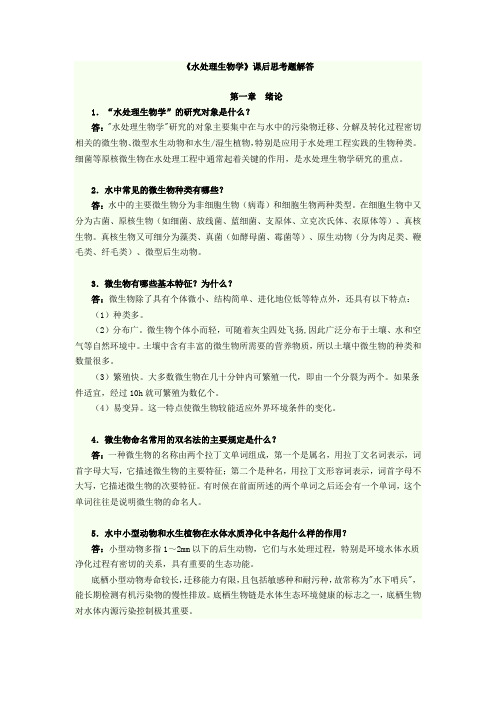
《水处理生物学》课后思考题解答第一章绪论1.“水处理生物学”的研究对象是什么?答:"水处理生物学"研究的对象主要集中在与水中的污染物迁移、分解及转化过程密切相关的微生物、微型水生动物和水生/湿生植物,特别是应用于水处理工程实践的生物种类。
细菌等原核微生物在水处理工程中通常起着关键的作用,是水处理生物学研究的重点。
2.水中常见的微生物种类有哪些?答:水中的主要微生物分为非细胞生物(病毒)和细胞生物两种类型。
在细胞生物中又分为古菌、原核生物(如细菌、放线菌、蓝细菌、支原体、立克次氏体、衣原体等)、真核生物。
真核生物又可细分为藻类、真菌(如酵母菌、霉菌等)、原生动物(分为肉足类、鞭毛类、纤毛类)、微型后生动物。
3.微生物有哪些基本特征?为什么?答:微生物除了具有个体微小、结构简单、进化地位低等特点外,还具有以下特点:(1)种类多。
(2)分布广。
微生物个体小而轻,可随着灰尘四处飞扬,因此广泛分布于土壤、水和空气等自然环境中。
土壤中含有丰富的微生物所需要的营养物质,所以土壤中微生物的种类和数量很多。
(3)繁殖快。
大多数微生物在几十分钟内可繁殖一代,即由一个分裂为两个。
如果条件适宜,经过10h就可繁殖为数亿个。
(4)易变异。
这一特点使微生物较能适应外界环境条件的变化。
4.微生物命名常用的双名法的主要规定是什么?答:一种微生物的名称由两个拉丁文单词组成,第一个是属名,用拉丁文名词表示,词首字母大写,它描述微生物的主要特征;第二个是种名,用拉丁文形容词表示,词首字母不大写,它描述微生物的次要特征。
有时候在前面所述的两个单词之后还会有一个单词,这个单词往往是说明微生物的命名人。
5.水中小型动物和水生植物在水体水质净化中各起什么样的作用?答:小型动物多指1~2mm以下的后生动物,它们与水处理过程,特别是环境水体水质净化过程有密切的关系,具有重要的生态功能。
底栖小型动物寿命较长,迁移能力有限,且包括敏感种和耐污种,故常称为"水下哨兵",能长期检测有机污染物的慢性排放。
- 1、下载文档前请自行甄别文档内容的完整性,平台不提供额外的编辑、内容补充、找答案等附加服务。
- 2、"仅部分预览"的文档,不可在线预览部分如存在完整性等问题,可反馈申请退款(可完整预览的文档不适用该条件!)。
- 3、如文档侵犯您的权益,请联系客服反馈,我们会尽快为您处理(人工客服工作时间:9:00-18:30)。
(b)2 mol CO2and 1 molpropanal(CH3CH2CHO) uses 5C and 7+6+3=16 e-eq. We need one C and 8 e-. Then one mole CH4will be produced.
1.28Solution: for (a) and (b), please see the below figure,
CH3CH2CH2CH2OH
NAD+NADH+H+
CH3CH2CH2CHO
NAD+NADH+H+
+H2O
CH3CH2CH2COOH
HS-CoA
+ATP H2O+AMP+PPi
CH3CH2CH2COSCoA
b) Replication produces the double-strandeddeoxyribonucleotide.Transcription produces the string-strandedribonucleotide.
1.24mRNA is the transcribed genetic code used to direct protein synthesis.
1.18 Bacteria gain energy through the oxidation of an electron donor,and common electron donors are organic compounds.Algaecreatesorganic compounds-the algae themselves and their product. Thus in this context,becausethe primaryproduction generates their electron donor. (algaephotosynthesis also generates , anaccepterfor aerobicrespiration.)
1.31a, c
Generation of the proton motive force during aerobicrespiration,fromBrock biology of microorgani
1.371. NO 2.yes 3.perhaps4.yes-via mutation 5.yes
1.221、The feast and famine regime gains greater total polysaccharides and an increase in theα-glycosidicbonds, asα-glycosidicbonds are associated with storage materials, like glycogen .It appears that the feast and famine regime is causing the cells to accumulate more storage materials.
3FADH2=3*2ATP=6ATP
2GTP
-2ATP
Sum, 33ATP
1.29(a)C6H12O6has 6 carbons , 6×4=24 e-equivalent
2 mole CH3COOH take 4C, 2×8=16 e-equivalent ,
The 2 CO2take the last C
13、The membrane is a lipid bi-lager with a hydrophobic interior ionic species
17coenzymeis the best answer.
A coenzyme is non-protein molecule that is not a metal(a cofactor). And not verytightly bond (the prostheticgroup ).Theapoenzymeis protein without the attached groups.
1.38The secondary, tertiary, or quaternary structure is established by hydrogen, disulfidebonds,and these can be destroyed by extreme in PH, which affect the change on protein functional groups ,like -SH, -OH, -COOH, and - , thus, an extreme PH can denature the enzymes nature and reduceituseorinefficientforcatalysis.
CH3CH2CH2CH2OH+3NAD++FAD+H2O+2HS-CoA+ATP= 2CH3COSCoA+3NADH+2H++ FADH2+AMP+PPi
CH3COSCoA +3NAD++FAD+GDP+Pi+3H2O=
2CO2+3NADH+3H++FADH2+GTP+HSCoA
Then, 9NADH+9H+= 9*3ATP=27 ATP
tRNAis the agent that matches the code(in mRNA)andbringsthe amino acidto the ribosome during protein production.
1.25
1、
01
1.27 Membrane-boundATPasescatalyze the reaction forming ATP fromADP+Pi. The reaction allows the re-entry of protons across the membrane in controlled amounts. Energy from the proton gradient (which required energy to form) is captured and used to drive the energy-consuming formation of ATP.
Solution:2、Polysaccharides glycogen are themainformof carbon and energy reserves. During feast period, the bacteria rapidly take up and sequester the substrate, by sequestering much more polysaccharides as an internal storage product, theydonotneed to have a rapid growth rate during the feast period, instead, they have a relatively steady growthrate that is based on the gradual utilization of internal storage products during the famine period.
1.23 a) Replication occurs only right before cell division. Transcription occurs whereas the cell needs the protein product, which could occurmore frequently.
FAD FADH2
CH3CHCHCOSCoA
H2O
CH3CHOHCH2COSCoA
NAD+
NADH+H+
CH3COCH2COSCoA
HS-CoA
CH3COSCoA+ CH3COSCoA
Then turn into the citric acid cycle
For (c), the overall reactionis ,
(2 +C6H12O6 2 CH3COOH+2 CO2+4H2C6H12O6 CH3CH2CHO+2CO2+CH4+ )
1.30Cyanobacteriaare oxygenicphototrophs. isthe electron donor, and is product. Green and purple bacteria areanoxygenicphototrophs. They use or as the electron donor. They glow phototrophically only under anaerobicconditions ,astheir pigment is notsynthesized in the presence of oxygen .
